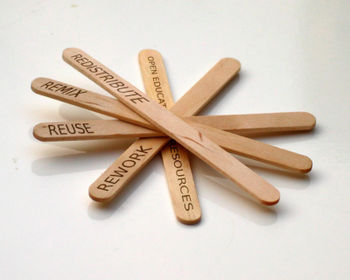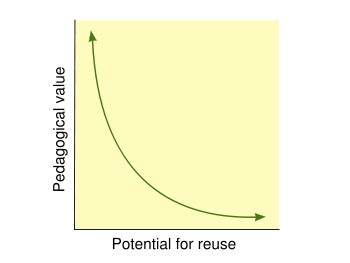Digital skills for collaborative OER development/Orientation/Reusability paradox
Contents
The reusability paradox
The OER strategic point of difference when compared to closed materials lies in the ability to reuse, rework, remix and redistribute learning materials. There are pedagogical and technological constraints which can diminish the reuse potential of OER. When developing OER courses, it is important to design and structure courses to maximise reuse potential and to consider technology choices which will not constrain delivery options downstream.The value proposition for reusing OER versus building from scratch is based on a cost-benefit decision by the educator:
| Cost of repurposing should be less than the Benefits of developing a new OER |
The cost of recontextualisation, that is, the time required to re-purpose an OER for a different educational context, should conceptually be less than the perceived benefits of developing a new OER from scratch. Moreover, open development using collaborative technologies generates opportunities for cooperative development which can reduce cost and improve quality by sharing the workload and design ideas.
The reusability challenge
Educationally speaking, reuse means placing an OER into a different learning context from that for which it was originally designed and developed. Meaningful learning is closely related to the learner's context. For instance, an OER Physics lesson dealing with Newton's second law of motion based on an activity using the example of a London bus will have little meaning or context for learners in rural Uganda who have never seen a London bus. While this OER example may be pedagogically effective for children in the United Kingdom, it has significantly less reuse potential for children in Africa. Consequently, there is an inverse relationship between pedagogical effectiveness of OERs and their potential for reuse -- hence the reusability paradox (Wiley 2004: online)[1]
Effective OER reuse may require recontextualisation of the resource. The example of the Physics lesson above is used to illustrate that educational elements embedded within OER could restrict reuse, but this example is understandably an oversimplification of the pedagogical challenges associated with remixing.
We can improve the reuse potential for OER by:
- building capacity and skills to remix OER
- focusing on reuse as a design criterion when developing courses
- selecting technologies which facilitate reuse.
Designing for reuse
Improving reusability is simultaneously a technical, pedagogical and pragmatic challenge:
Technical challenges
OER should ideally be developed and stored in editable formats using open standards and open file formats thus enabling educators to easily adapt and modify materials with the tools of their choice[2].
For instance, the OERu develops courses using WikiEducator which is powered by the Mediawiki open source software technology. Content is stored in open file formats with a detailed version history for cooperative development. Moreover, the Mediawiki software has the capability to produce customised pdf versions of course materials for learner who don't have easy access to the Internet and the option to download these customisations in open document format[3] for off line editing. The OER Foundation who coordinates the implementation of the OERu has also developed technology to enable users to convert materials from WikiEducator for hosting on their own websites.
Incorporating interactions which are technology dependant, for example embedding custom activities, for instance a WebQuest or case study sequence which relies on the functionality of a specific authoring environment will restrict reuse in other delivery technologies which do not support these custom software features.
Pedagogical challenges
The ability to identify the educational elements embedded in the content as discrete components within OER would reduce the time and effort need to localise activities for different contexts.
For example, WikiEducator utilises a number of pedagogical templates which we call instructional devices (or iDevices). iDevices include a range of pedagogical forms and activity types, for instance, objectives, case studies, reading activities, etc. which are published a clearly identifiable components within the teaching materials. This simplifies the task of re-contextualising learning materials because the iDevices can be replaced with contextually relevant examples.
Pragmatic challenges
Separating content which relates to specific delivery instances of a course from the core OER materials will improve the potential for downstream reuse. For example:
- Avoid embedding the sequence in the text of the core OER resources where possible, for example Week 1, Week 2 or Unit 1 or Unit 2 etc. This will restrict downstream reuse for educators who would like to adopt the materials in a different sequence.
- Avoid the convention of numbering activities in the text of the source resource, for example Activity 1.2.5 (which might refer to the 5th activity of the 2nd section of the first Module.) It is better to use descriptive titles, for example: Activity: Find an OER Asset for Reuse in your course.
- Avoid embedding institutional specific information in the core resources, for example "Visit the subject librarian at the University of Southern Queensland for assistance in finding OER."
With careful thought and planning, these practical issues can easily be resolved. For example, an institution specific page which provides a table of activities and displays the unique numbering sequence, but links to the core materials which do not embed numbering or institution specific information.
References
- ↑ D. Wiley. 2004. The Reusability Paradox, Online: Connexions, April 20, 2004.
- ↑ This does not preclude educators from using proprietary software tools but provides the development community with open access to the formats used in these OER projects to foster innovation in remixing alternatives. More importantly, the commitment to editable formats using open standards ensures that educators, who for whatever reason are unable to afford the costs of using legal copies of closed-source software will not be restricted from participating in OER development and reuse.
- ↑ Open Document Format is a free and open standard used as the file format for office productivity software, eg word processing, spreadsheets etc.

